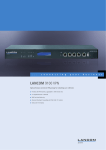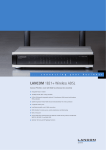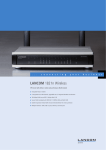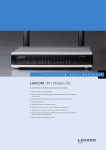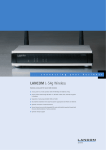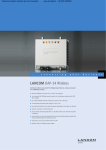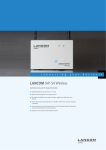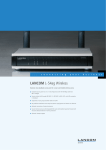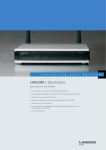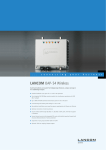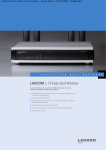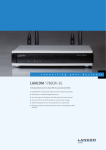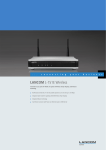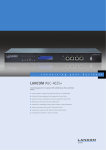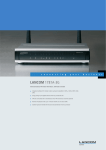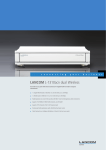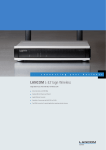Download 1823_DS - Logitel
Transcript
. . .
c o n n e c t i n g
y o u r
LANCOM 1823 VoIP
Business VoIP Router with WLAN and integrated IP PBX for analog, ISDN and SIP
telephony at sites with ISDN or analog exchange line
쮿 IP PBX for ISDN, analog and 8 SIP subscribers (up to 32 with VoIP- 32 Option)
쮿 SIP proxy for registration with providers and upstream VoIP PBXs
쮿 SIP gateway with transparent transition between SIP, ISDN and analog telephony
쮿 Intelligent call routing and number translation
쮿 Internal ISDN port with switchable life- line support (backup via ISDN exchange line)
쮿 Analog exchange line combined with a configurable ISDN port (TE/NT)
쮿 Two a/b ports for analog extension lines or small analog PBX
쮿 Stateful- inspection firewall and VPN gateway
쮿 WLAN router for 54/108 Mbps, 802.11a/g/b standards
b u s i n e s s
The LANCOM 1823 VoIP is a highly integrated all- round solution offering an IP PBX, SIP gateway, VPN router, access router, professional firewall and WLAN access point.
As a Business VoIP Router, the LANCOM 1823 VoIP offers interfaces for SIP and ISDN terminal equipment along with additional connectors for analog telephones and fax machines
as well as a connection to an anlog or ISDN exchange line.
Typical application scenarios include single sites or branch offices with up to 10 telephony subscribers using ISDN and/or analog terminal equipment–such as DECT telephones or
fax machines–which is to be integrated into VoIP communications.
Particularly practical for home or small offices the LANCOM 1823 VoIP can replace small PBX systems completely. With the choice for analog or ISDN outside line and the continued
use of existing analog devices it makes the universal communications solution.
More than just a new PBX.
The combination with ISDN or SIP telephones like the LANCOM VP- 100 makes a separate PBX completely superfluous. Basic functions of the traditional telephone system are
provided by the LANCOM router's VoIP Call Manager.
At the same time, the professional security, routing and network functions, including VPN, provide everything that modern companies need for their data networks.
Even Voice over VPN or Voice over WLAN (with separate Access Points) can be used in parallel with data networking. Free updates to the solution provide savings through
consolidation for true protection of this future- proof investment.
More Telephony.
Telephone calls can be automatically directed over existing VPN connections between company sites. Not only are these calls secured from interception; by using flatrate
connections, there are no additional call costs, either.
LANCOM opens up a cost- effective migration path between technologies of the 'old and new world' because existing ISDN and analog telephones and PBXs can be integrated and
operated side by side with SIP terminal equipment.
An internal ISDN and two analog connectors provide four simultaneous voice channels for optional combination with an analog or ISDN exchange line. For example, this allows
an existing ISDN PBX to be equipped with SIP, enhanced with analog and SIP terminal equipment, and additionally to be connected to an upstream VoIP PBX over VPN. Subscribers
can simultaneously make calls via ISDN telephones, analog phones, SIP equipment or softphones to other SIP or POTS subscribers, both internally and externally. The transition
between analog, ISDN and SIP is automatic and invisible to the user.
With life- line support either between the internal and external ISDN ports or from analog to analog, telephony remains possible even when the router is switched off. SIP
connections with redundancy and high reliability are ensured by backup over ISDN or analog exchange line, load balancing, and VRRP in combination with an Ethernet port as an
additional WAN interface. This ensures that telephony is just as reliable as ever, even with Voice over IP.
More Security.
The integrated firewall with the latest security functions such as stateful inspection, Intrusion Detection and Denial- of- Service protection is supplemented by dynamic bandwidth
management and comprehensive functions for backup, high- availability and redundancy. The integrated VPN gateway that fulfills the IPSec standard, and the optional hardware
accelerator provide optimal security for connecting telecommuters and branch offices thanks to the high- security 3- DES or AES encryption and support of digital certificates.
More Freedom.
In particular for smaller sites like sales offices, the LANCOM 1823 VoIP is the universal solution for secure voice and data communications. Thanks to the integrated dualband access
point compliant to IEEE 802.11a/h/b/g, this all- round gateway provides high data throughputs at up to 54/108 Mbps for mobile applications, and professional security with WPA2,
LEPS and IEEE 802.11i–just as business users would expect.
In combination with suitable terminal equipment for Voice over WLAN, a whole new level of freedom is available for flexible working and organization. LANCOM 1823 VoIP supports
wireless SIP telephony, specialized Quality of Service with IEEE 802.11e, fast roaming compliant with IEEE 802.11i and U- APSD (WMM Power Save).
More Benefits.
The versatile functions for address translation and routing allow completely different networks to be connected over common infrastructure. Existing networks at partner companies,
home- office workstations or subsidiaries can be integrated into the VPN without problem. The management software (LANconfig and LANmonitor) is included and offers not only
cost- effective remote maintenance of entire installations along with highly convenient setup wizards, but also full real- time monitoring and logging. What’s more, service providers
benefit from the broad range of scripting methods and professional access with individual access rights for administrators via SSH, HTTPS, TFTP and ISDN dial- in.
More Reliability for the Future.
From the very start, LANCOM products are designed for a product life of several years. They are equipped with hardware dimensioned for the future. Even reaching back to older
product generations, updates to the LANCOM Operating System–LCOS–are available several times a year, free of charge and offering major features. LANCOM offers unbeatable
protection of your investment!
LANCOM 1823 VoIP
Scope of features: as of LCOS version 7.8x
WLAN
Frequency band 2.4 GHz or 5 GHz
2400-2483.5 MHz (ISM) or 5150-5825 MHz (depending on country- specific restrictions)
Data rates 802.11b/g
54 Mbps to IEEE 802.11g (fallback to 48, 36, 24, 18, 12, 9, 6 Mbps, Automatic Rate Selection) compatible to IEEE 802.11b (11,
5.5, 2, 1 Mbps, Automatic Rate Selection), 802.11 b/g compatibility mode or pure g or pure b, Super A/G with Turbo Mode (108
Mbps), bursting, compression
Data rates 802.11a/ h
54 Mbps to IEEE 802.11a/h (fallback to 48, 36 , 24, 18, 12, 9, 6 Mbps, Automatic Rate Selection), Super A/G with Turbo Mode
(108 Mbps), bursting, compression, fully compatible with TPC (adjustable power output) and DFS (automatic channel selection,
radar detection) according to ETSI regulations.
Range 802.11a/b/g *
Up to 150 m (up to 30 m in buildings) *
Output power at antenna connector,
2.4 GHz
802.11b: +19 dBm @ 1 and 2 Mbps, +19 dBm @ 5.5 and 11 Mbps;
Output power at antenna connector, 5
GHz
802.11a/h: +18 dBm @ 6 Mbps, +12 dBm @ 54 Mbps with transmission power control (TPC) and manual power settings
Max. radiated power (EIRP),
802.11b/g: Up to 20 dBm / 100 mW EIRP (transmission power control according to TPC or manual settings)
802.11g: +19 dBm @ 6 Mbps, +14 dBm @ 54 Mbps
2.4 GHz band
Max. radiated power (EIRP),
5 GHz band
802.11a/h: Up to 30 dBm / 1000 mW or up to 36 dBm / 4000 mW EIRP (depending on national regulation on channel usage and
subject to further obligations such as TPC and DFS)
Minimum transmission power
Transmission power reduction in software in 1 dB steps to min. 0.5 dBm
Reception sensitivity 2.4 GHz
802.11b: - 87 dBm @ 11 Mbps, - 94 dBm @ 1 Mbps
Reception sensitivity 5 GHz
802.11a/h: - 67 dBm @ 54 Mbps; - 87 dBm @ 6 Mbps
Radio channels 2.4 GHz
Up to 13 channels, max. 3 non- overlapping (2.4 GHz band)
Radio channels 5 GHz
Up to 26 non- overlapping channels (available channels and further obligations such as automatic DFS2 dynamic channel
selection depending on national regulation)
Roaming
Seamless handover between radio cells, IAPP support with optional restriction to an ARF context, IEEE 802.11d support
WPA2 fast roaming
Pre- authentication and PMK caching for fast roaming
Fast client roaming
With background scanning, moving LANCOM 'client mode' access points pre- authenticate to alternative access points which
offer a better signal before Roaming fails
VLAN
VLAN ID definable per interface, WLAN SSID, point- to- point connection and routing context (4094 IDs)
Dynamic VLAN assignment
Dynamic VLAN assignment for target user groups based on MAC addresses, BSSID or SSID by means of external RADIUS server.
Q- in- Q tagging
Support of layered 802.1q VLANs (double tagging)
Multi- SSID
Simultaneous use of up to 8 independent WLAN networks per WLAN interface
IGMP snooping
Support for Internet Group Management Protocol (IGMP) in the WLAN bridge for WLAN SSIDs and LAN interfaces for specific
switching of multicast packets (devices with integrated WLAN only). Automated detection of multicast groups. Configurable
action for multicast packets without registration. Configuration of static multicast group members per VLAN ID. Configuration
of query simulation for multicast membership per VLAN ID
Security
IEEE 802.11i / WPA2 with passphrase or 802.1x and hardware- accelerated AES, closed network, WEP64, WEP128, WEP152,
user authentication, 802.1x /EAP, LEPS, WPA1/TKIP
RADIUS server
Integrated RADIUS server for MAC address list management
EAP server
Integrated EAP server for authentication of 802.1x clients via EAP- TLS, EAP- TTLS, PEAP, MSCHAP or MSCHAPv2
Quality of Service
Prioritization according to Wireless Multimedia Extensions (WME, subset of IEEE 802.11e)
U- APSD/WMM Power Save
Extension of power saving according to IEEE 802.11e by Unscheduled Automatic Power Save Delivery (equivalent to WMM Power
Save). U- APSD supports the automatic switch of clients to a doze mode. Increasmed battery lifetime for telephone calls over
VoWLAN (Voice over WLAN)
Bandwidth limitation
Maximum transmit and receive rates and an individual VLAN ID can be assigned to each WLAN client (MAC address)
Background scanning
Detection of rogue AP's and the channel information for all WLAN channels during normal AP operation.
The Background Scan Time Interval defines the time slots in which an AP or Router searches for a foreign WLAN network in its
vicinity. The time interval can be specified in either milliseconds, seconds, minutes, hours or days
Client detection
Rogue WLAN client detection based on probe requests
802.1x supplicant
Authentication of an access point in WLAN client mode at another access point via 802.1x (EAP- TLS, EAP- TTLS and PEAP)
*) Note
The effective distances and transmission rates that can be achieved are depending of the site RF conditions
LANCOM 1823 VoIP
Scope of features: as of LCOS version 7.8x
WLAN operating modes
WLAN access point
Infrastructure mode (autonomous operation or managed by LANCOM WLAN Controller)
WLAN bridge
Point- to- multipoint connection of up to 7 Ethernet LANs (mixed operation optional), broken link detection, blind mode, supports
VLAN
When configuring Pt- to- Pt links, pre- configured names can be used as an alternative to MAC Adresses for creating a link. Rapid
spanning- tree protocol to support redundant routes in Ethernet networks
WLAN client
Transparent WLAN client mode for wireless Ethernet extensions, e.g. connecting PCs or printers by Ethernet; up to 64 MAC
addresses. Automatic selection of a WLAN profile (max. 8) with individual access parameters depending on signal strength or
priority
Firewall
Stateful inspection firewall
Incoming/Outgoing Traffic inspection based on connection information. Trigger for firewall rules depending on backup status,
e.g. simplified rule sets for low- bandwidth backup lines. Limitation of the number of sessions per remote site (ID)
Packet filter
Check based on the header information of an IP packet (IP or MAC source/destination addresses; source/destination ports,
DiffServ attribute); remote- site dependant, direction dependant, bandwidth dependant
Extended port forwarding
Network Address Translation (NAT) based on protocol and WAN address, i.e. to make internal webservers accessible from WAN
N:N IP address mapping
N:N IP address mapping for translation of IP addresses or entire networks
Tagging
The firewall marks packets with routing tags, e.g. for policy- based routing
Actions
Forward, drop, reject, block sender address, close destination port, disconnect
Notification
Via e- mail, SYSLOG or SNMP trap
Quality of Service
Traffic shaping
Dynamic bandwidth management with IP traffic shaping
Bandwidth reservation
Dynamic reservation of minimum and maximum bandwidths, totally or connection based, separate settings for send and receive
directions. Setting relative bandwidth limits for QoS in percent
DiffServ/TOS
Priority queuing of packets based on DiffServ/TOS fields
Packet- size control
Automatic packet- size control by fragmentation or Path Maximum Transmission Unit (PMTU) adjustment
Layer 2/Layer 3 tagging
Automatic or fixed translation of layer- 2 priority information (802.11p- marked Ethernet frames) to layer- 3 DiffServ attributes in
routing mode. Translation from layer 3 to layer 2 with automatic recognition of 802.1p- support in the destination device
Security
Intrusion Prevention
Monitoring and blocking of login attempts and port scans
IP spoofing
Source IP address check on all interfaces: only IP addresses belonging to the defined IP networks are allowed
Access control lists
Filtering of IP or MAC addresses and preset protocols for configuration access and LANCAPI
Denial of Service protection
Protection from fragmentation errors and SYN flooding
General
Detailed settings for handling reassembly, PING, stealth mode and AUTH port
URL blocker
Filtering of unwanted URLs based on DNS hitlists and wildcard filters
Password protection
Password- protected configuration access can be set for each interface
Alerts
Alerts via e- mail, SNMP- Traps and SYSLOG
Authentication mechanisms
EAP- TLS, EAP- TTLS, PEAP, MS- CHAP, MS- CHAPv2 as EAP authentication mechanisms, PAP, CHAP, MS- CHAP and MS- CHAPv2
as PPP authentication mechanisms
Anti- theft
Anti- theft ISDN site verification over B or D channel (self- initiated call back and blocking)
WLAN protocol filters
Limitation of the allowed transfer protocols, source and target addresses on the WLAN interface
Adjustable reset button
Adjustable reset button for 'ignore', 'boot- only' and 'reset- or- boot'
IP redirect
Fixed redirection of any packet received over the WLAN interface to a dedicated target address
High availability / redundancy
VRRP
VRRP (Virtual Router Redundancy Protocol) for backup in case of failure of a device or remote station. Enables passive standby
groups or reciprocal backup between multiple active devices including load balancing and user definable backup priorities
FirmSafe
For completely safe software upgrades thanks to two stored firmware versions, incl. test mode for firmware updates
ISDN backup
In case of failure of the main connection, a backup connection is established over ISDN. Automatic return to the main connection
Analog/GSM modem backup
Optional operation of an analog or GSM modem at the serial interface
LANCOM 1823 VoIP
Scope of features: as of LCOS version 7.8x
High availability / redundancy
Load balancing
Static and dynamic load balancing over up to 2 WAN connections. Channel bundling with Multilink PPP (if supported by network
operator)
VPN redundancy
Backup of VPN connections across different hierarchy levels, e.g. in case of failure of a central VPN concentrator and re- routing
to multiple distributed remote sites. Any number of VPN remote sites can be defined (the tunnel limit applies only to active
connections). Up to 32 alternative remote stations, each with its own routing tag, can be defined per VPN connection. Automatic
selection may be sequential, or dependant on the last connection, or random (VPN load balancing)
Line monitoring
Line monitoring with LCP echo monitoring, dead- peer detection and up to 4 addresses for end- to- end monitoring with ICMP
polling
VPN
Number of VPN tunnels
5 IPSec connections active simultaneously (25 with VPN- 25 Option), unlimited configurable connections. Configuration of all
remote sites via one configuration entry when using the RAS user template or Proadaptive VPN. Max. total sum of concurrently
active IPSec and PPTP tunnels: 5 (25 with VPN 25 Option)
Hardware accelerator
Integrated hardware accelerator for 3DES/AES encryption and decryption
1- Click- VPN Client assistant
One click function in LANconfig to create VPN client connections, incl. automatic profile creation for the LANCOM Advanced
VPN Client
1- Click- VPN Site- to- Site
Creation of VPN connections between LANCOM routers via drag and drop in LANconfig
IKE
IPSec key exchange with Preshared Key or certificate
Certificates
X.509 digital multi- level certificate support, compatible with Microsoft Server / Enterprise Server and OpenSSL, upload of
PKCS#12 files via HTTPS interface and LANconfig. Simultaneous support of multiple certification authorities with the
management of up to nine parallel certificate hierarchies as containers (VPN- 1 to VPN- 9). Simplified addressing of individual
certificates by the hierarchy's container name (VPN- 1 to VPN- 9). Wildcards for certificate checks of parts of the identity in the
subject. Secure Key Storage protects a private key (PKCS#12) from theft
Certificate rollout
Automatic creation, rollout and renewal of certificates via SCEP (Simple Certificate Enrollment Protocol) per certificate hierarchy
Certificate revocation lists (CRL)
CRL retrieval via HTTP per certificate hierarchy
XAUTH
XAUTH client for registering LANCOM routers and access points at XAUTH servers incl. IKE- config mode. XAUTH server enables
clients to register via XAUTH at LANCOM routers. Connection of the XAUTH server to RADIUS servers provides the central
authentication of VPN- access with user name and password. Authentication of VPN- client access via XAUTH and RADIUS
connection additionally by OTP token
RAS user template
Configuration of all VPN client connections in IKE ConfigMode via a single configuration entry
Proadaptive VPN
Automated configuration and dynamic creation of all necessary VPN and routing entries based on a default entry for site- tosite connections. Propagation of dynamically learned routes via RIPv2 if required
Algorithms
3DES (168 bit), AES (128, 192 or 256 bit), Blowfish (128 bit), RSA (128 or - 448 bit) and CAST (128 bit). OpenSSL implementation
with FIPS- 140 certified algorithms. MD- 5 or SHA- 1 hashes
NAT- Traversal
NAT- Traversal (NAT- T) support for VPN over routes without VPN passthrough
IPCOMP
VPN data compression based on LZS or Deflate compression for higher IPSec throughput
LANCOM Dynamic VPN
Enables VPN connections from or to dynamic IP addresses. The IP address is communicated via ISDN B- or D- channel or with
the ICMP or UDP protocol in encrypted form. Dynamic dial- in for remote sites via connection template
Dynamic DNS
Enables the registration of IP addresses with a Dynamic DNS provider in the case that fixed IP addresses are not used for the
VPN connection
Specific DNS forwarding
DNS forwarding according to DNS domain, e.g. internal names are translated by proprietary DNS servers in the VPN. External
names are translated by Internet DNS servers
VPN throughput (max., AES)
1416- byte frame size UDP
46 Mbps
256- byte frame size UDP
8 Mbps
IMIX
14 Mbps
Firewall throughput (max.)
1518- byte frame size UDP
65 Mbps
256- byte frame size UDP
17 Mbps
LANCOM 1823 VoIP
Scope of features: as of LCOS version 7.8x
VoIP
Number of local subscribers
max. 8 (upgradable to 32 with LANCOM VoIP- 32 Option)
PBX functionality
Switching between local analog, ISDN, SIP subscribers and upstream SIP PBXs or external analog, ISDN and SIP subscribers.
E.g. support for: Hold/Request, Swap, Transfer, Call Forwarding (CFU, CFB, CFNR), settings per subscriber for original, local
subscriber or user defined calling party ID in case of Call Forwarding, number display/suppression (CLIP, CLIR), named internal
subscribers, suppression of second call (Busy on Busy), immediate outgoing line, AOC (at internal ISDN), hunt groups, call
diversion
Analog, ISDN or SIP subscriber initiated actions:
쮿 Hold/Consultation, Swap, Transfer
쮿 Call Forwarding unconditional (CFU), on busy (CFB), on no reply (CFNR)
Hunt groups
Hunt group cascades with groups as group members. Call diversion to all members simultaneously or sequentially. Automatic
forwarding to target number or hunt group after timeout or when busy/unreachable
Multi login
Registration of several SIP terminal devices with the same number/ID. Signaling like with a single subscriber, e.g. tabletop
telephone, softphone and mobile handset at the same time
Call router
Central switching of all incoming and outgoing calls. Number translation by mapping, numeral replacement and number
supplementation. Configuration of line and route selection, entry of multiple alternative routes (line backup). Routing based on
calling and called number, SIP domain and line. Manual routing by the user ('outside- line access codes'). Routing with lineselection keys on telephones or telephone number prefixes. Targeted routing for individual telephone numbers (e.g. emergency
calls via local ISDN). Separate routes for internal, local, long- distance or international calls. Blocking of telephone numbers or
blocks of telephone numbers. Inclusion of local subscribers into the number range of an upstream SIP PBX. Internal standard
telephone number for undeliverable calls. Supplement/remove line- related prefixes or switchboard numbers
SIP registrar
Management of local SIP users with optional automatic registration/authentication at SIP providers/upstream SIP PBXs. Optional
shared/individual password for authentication at an upstream SIP PBX. Default DNS entry for the local SIP domains, service
location (SRV) support. Configurable registration (with/without) and line monitoring (inactive, automatic, with re- registration,
with OPTIONS requests) for SIP trunk, link, remote gateway and SIP PBX line
SIP proxy
Mapping of up to 16 public SIP- provider accounts as telephone lines for shared use. Connection to up to four upstream SIP PBXs
including line backup. SIP connections from/to internal subscribers, SIP providers and SIP PBXs. Automatic bandwidth
management and automatic configuration of the firewall for SIP connections. Support of early and late initiation of SDP
negotiation (SDP offer in INVITE or OK). Switchable support of privacy/call screening (call number suppression) per line compliant
with RFC 3325 or with remote party ID when set for subscriber (CLIR). Support of Request URI (RFC 3261)
SIP gateway
Transparent conversion of analog or ISDN telephone calls to SIP calls, and vice versa. Local ISDN and analog subscribers register
as local SIP users, and local ISDN/analog subscribers automatically register as SIP users at upstream SIP PBXs or SIP providers.
Number translation between internal numbers and MSN/DDI (including telephone number blocks) or external numbers, plus
automatic adaptation of calling numbers and called numbers
SIP trunk
Outgoing call switching and incoming call reception based on extension numbers to/from SIP PBXs/SIP providers (requires
support of the SIP- DDI functions compliant with ITU- T Q.1912.5 at the central exchange) with a registration of the switchboard
number or without any registration (fixed configuration on both sides). Mapping of entire SIP telephone number blocks
SIP link
Outgoing call switching and incoming call reception of any numbers to/from SIP PBXs/SIP providers (requires support of this
function at the central exchange) with a single registration or without registration (fixed configuration on both sides). Mapping
of entire SIP telephone number blocks
SIP remote gateway
Local break- in/out of calls with any telephone number to/from upstream VoIP PBXs/SIP providers with telephone number
mapping, independent of local users
Media proxy
Termination and interconnection of multiple media streams. Control of media sessions resulting from SIP connections. IP address
and port translation for media stream packets. Connection of parties at media stream level where a call transfer in SIP (REFER)
is not possible
Number of simultaneous connections
2 - 16 depending on code conversion, echo canceling and load
Signaling
VoIP: SIPv2, ISDN: DSS1 (Euro- ISDN), point- to- point/point- to- multipoint; 1TR6 (only at an external ISDN connector in TE mode)
Media protocols
RTP
ISDN features
Operation directly at ISDN exchange lines or at ISDN extension lines of existing PBXs. Provision of exchange lines or extension
lines. ISDN supplementary services CLIP, CLIR, en- block dial and individual dialing with adjustable wait- time until completion.
Transparent pass- through of data services and ISDN facilities to control switching exchanges (in case of default ISDN interface
configuration). ISDN- UDI calls with G.722. Pass- through of service identifiers (BC, HLC, LLC) for ISDN- to- ISDN connections. PCM
bit- transparent coupling. Support for keypad facilities. Advice of charge (AOC- D, AOC- E). 'DSS1 NT reverse' and 'DSS1 NT pointto- point reverse' for ISDN clock synchronization with suitable PBXs. ISDN S0 buses can be collected into hunting groups. Parallel
operation of point- to- point and point- to- multipoint connections
Analog features
Operation directly at analog exchange lines (FXO with DTMF). Internal FXS ports (DTMF) for one analog terminal device each,
or as an analog PBX exchange line. Metering pulses from ISDN calls (AOC- D, AOC- E ) passed- through to terminal equipment at
the FXS ports. Caller- ID support at the analog exchange line and the internal FXS ports (FSK, DTMF)
Audio properties
Echo canceling (G.168), automatic adaptive de- jitter buffer. Inband tone signaling compliant with EU standards and countryspecific. DTMF support compliant with RFC 2976 (SIP info), RFC 2833 (RTP payload type/outband). Transparent pass- through
for negotiated codecs. Interaction on codec negotiation between subscribers (filter, quality/bandwidth) Voice encoding with
G.711 μ- law/A- law (64 kbps), G.722 high- quality codec (payload is passed through, no conversion of different G.722 encoding
variants), G.729 Annex A
Fax transmission
Transmisson of fax via SIP on the LAN side with T.38 or G.711, on the WAN/Internet side with T.38. Conversion of SIP fax with
T.38 and break- in/break- out at the outside line to ISDN G.711 with service signalisation or to analog fax (depending on line
type). Connection and conversion to SIP T.38 or G.711 for analog or ISDN fax machines
LANCOM 1823 VoIP
Scope of features: as of LCOS version 7.8x
VoIP
Auto QoS
Automatic dynamic bandwidth reservation per SIP connection. Automatic selection of compression method depending upon
available bandwidth. Voice packet prioritization (CoS), DiffServ marking, traffic shaping (incoming/outgoing) and packet- size
management of non- prioritized connections compared to VoIP. Independent settings for DiffServ marking of signaling (SIP) and
media streams (RTP)
VoIP management
VoIP Setup Wizard and configuration with LANconfig. Configuration and tracing with command line interface (remote or locally)
VoIP monitoring
Reporting of Call Data Records (CDR) via SYSLOG or e- mail. Status display of subscribers, lines, and connections. Logging of
VoIP Call Manager events in LANmonitor. SYSLOG and TRACE for voice connections. Active monitoring even of ISDN interface
states with SNMP
Routing functions
Router
IP, IPX and NetBIOS/IP multi- protocol router
ARP lookup
Packets sent in response to LCOS service requests (e.g. for Telnet, SSH, SNTP, SMTP, HTTP(S), SNMP, etc.) via Ethernet can be
routed directly to the requesting station (default) or to a target determined by ARP lookup
Advanced Routing and Forwarding
Separate processing of 16 contexts due to virtualization of the routers. Mapping to VLANs and complete independent
management and configuration of IP networks in the device, i.e. individual settings for DHCP, DNS, Firewalling, QoS, VLAN,
Routing etc. Automatic learning of routing tags for ARF contexts from the routing table
HTTP
HTTP and HTTPS server for configuration by web interface
DNS
DNS client, DNS server, DNS relay, DNS proxy and dynamic DNS client
DHCP
DHCP client, DHCP relay and DHCP server with autodetection. Cluster of several LANCOM DHCP servers per context (ARF
network) enables caching of all DNS assignments at each router
NetBIOS
NetBIOS/IP proxy
NTP
NTP client and SNTP server, automatic adjustment for daylight- saving time
Policy- based routing
Policy- based routing based on routing tags. Based on firewall rules, certain data types are marked for specific routing, e.g. to
particular remote sites or lines
Dynamic routing
Dynamic routing with RIPv2. Learning and propagating routes; separate settings for LAN and WAN. Extended RIPv2 including
HopCount, Poisoned Reverse, Triggered Update for LAN (acc. to RFC 2453) and WAN (acc. to RFC 2091) as well as filter options
for propagation of routes. Definition of RIP sources with wildcards
COM port server
COM port forwarding
COM- port server for DIN and USB interfaces. For multiple serial devices connected to it, the server also manages its own virtual
COM ports via Telnet (RFC 2217) for remote maintenance (works with popular virtual COM- port drivers compliant with RFC
2217). Switchable newline conversion and alternative binary mode. TCP keepalive according to RFC 1122 with configurable
keepalive interval, retransmission timeout and retries
USB print server
Print server (USB 2.0)
Host port for connecting USB printers via RAW- IP and LPD; bi- directional data exchange is possible
LAN protocols
IP
ARP, proxy ARP, BOOTP, LANCAPI, DHCP, DNS, HTTP, HTTPS, IP, ICMP, NTP/SNTP, NetBIOS, PPPoE (server), RADIUS, RIP- 1, RIP2, RTP, SIP, SNMP, TCP, TFTP, UDP, VRRP
IPX
RIP, SAP, IPX and SPX watchdogs, NetBIOS watchdogs
Rapid Spanning Tree
802.1d Spanning Tree and 802.1w Rapid Spanning Tree support for dynamic path selection with redundant layer 2 connections
WAN protocols
ADSL, Ethernet
PPPoE, PPPoA, IPoA, Multi- PPPoE, ML- PPP, PPTP (PAC or PNS) and plain Ethernet (with or without DHCP), RIP- 1, RIP- 2, VLAN
ISDN
1TR6, DSS1 (Euro- ISDN), PPP, X75, HDLC, ML- PPP, V.110/GSM/HSCSD, CAPI 2.0 via LANCAPI, Stac data compression
Interfaces
WAN: ADSL
ADSL over ISDN compliant with ITU G.992.1 Annex B (compatible to Deutsche Telekom U- R2 connections) or ADSL over POTS
compliant with ITU G.992.1 Annex A
WAN: ADSL2+
ADSL2+ over ISDN compliant with ITU G.992.3, ITU G.992.5 Annex B (ADSL2+) or ADSL2+ over POTS compliant with ITU G.992.3
and ITU G.992.5 Annex A (ADSL2+)
Ethernet ports
2 individual 10/100- Mbps Fast Ethernet ports; one can be switched as an additional WAN port with load balancing. Ethernet
ports can be electrically disabled within LCOS configuration
- freely configurable
Each Ethernet port can be freely configured (LAN, DMZ, WAN, monitor port, off). LAN ports can be operated as a switch or
separately. Additionally, external DSL modems or termination routers can be operated as a WAN port with load balancing and
policy- based routing. DMZ ports can be operated with their own IP address range without NAT
USB 2.0 host port
USB 2.0 full- speed host port for connecting USB printers (USB print server) or serial devices (COM port server); bi- directional
data exchange is possible (max. 12 Mbps)
ISDN
2 ISDN BRI ports (S0 bus); ISDN1: combined with an analog exchange line (selected by the corresponding connector cable), TE/
NT mode switchable with cross- over adapter, termination switchable; ISDN2: switchable active power feed, switchable ISDN1ISDN2 signaling pass- through, NT/TE mode switchable with cross- over adapter (ISDN2 TE not suitable for connection to an
external exchange)
LANCOM 1823 VoIP
Scope of features: as of LCOS version 7.8x
Interfaces
Analog
3 analog ports, 1x analog exchange line (FXO) combined with ISDN1 (selected by the corresponding connector cable), 2x internal
FXS ports (Analog1, Analog2) each for one analog device/line, within enclosed buildings only, maximum cable length 120m.
Signaling pass- through between analog exchange line (FXO) and Analog1 (FXS) in life- line mode
Serial interface
Serial configuration interface / COM port (8 pin Mini- DIN): 9,600 - 115,000 baud, suitable for optional connection of analog/
GPRS modems
External antenna connectors
Two reverse SMA connectors for external LANCOM AirLancer Extender antennas or for antennas from other vendors. Please
respect the restrictions which apply in your country when setting up an antenna system. For information about calculating the
correct antenna setup, please refer to www.lancom- systems.com
Management
LANconfig
Configuration program for Microsoft Windows, incl. convenient Setup Wizards. Optional group configuration, simultaneous
remote configuration and management of multiple devices over ISDN dial- in or IP connection (HTTPS, HTTP, TFTP). Configuration
program properties per project or user. Automatic storage of the current configuration before firmware updates. Exchange of
configuration files between similar devices, e.g. for migrating existing configurations to new LANCOM products. Detection and
display of the LANCOM managed switches
LANmonitor
Monitoring application for Microsoft Windows for (remote) surveillance and logging of the status of LANCOM devices and
connections, incl. PING diagnosis and TRACE with filters and save to file. Search function within TRACE tasks. Wizards for
standard diagnostics. Export of diagnostic files for support purposes (including bootlog, sysinfo and device configuration
without passwords). Graphic display of key values (marked with an icon in LANmonitor view) over time as well as table for
minimum, maximum and average in a separate window, e. g. for Rx, Tx, CPU load, free memory. Monitoring of the LANCOM
managed switches
WLANmonitor
Monitoring application for Microsoft Windows for the visualization and monitoring of LANCOM WLAN installations, incl. Rogue
AP and Rogue Client visualization
Firwall GUI
Graphical user interface for configuring the object- oriented firewall in LANconfig: Tabular presentation with symbols for rapid
understanding of objects, choice of symbols for objects, objects for actions/Quality of Service/remote sites/services, default
objects for common scenarios, individual object definition (e.g. for user groups)
WEBconfig
Integrated web server for the configuration of LANCOM devices via Internet browsers with HTTPS or HTTP. Similar to LANconfig
with a system overview, syslog and events display, symbols in the menu tree, quick access with side tabs. WEBconfig also
features Wizards for basic configuration, security, Internet access, LAN- LAN coupling. Online help for parameters in LCOS menu
tree
Device Syslog
Syslog buffer in the RAM (size depending on device memory) to store events for diagnosis. Default set of rules for the event
protocol in Syslog. The rules can be modified by the administrator. Display and saving of internal Syslog buffer (events) from
LANCOM devices with LANmonitor, display only with WEBconfig
Access rights
Individual access and function rights for up to 16 administrators
User administration
RADIUS user administration for dial- in access (PPP/PPTP and ISDN CLIP). Support for RADSEC (Secure RADIUS) for secure
communication with RADIUS servers.
Remote maintenance
Remote configuration with Telnet/SSL, SSH (with password or public key), browser (HTTP/HTTPS), TFTP or SNMP, firmware upload
via HTTP/HTTPS or TFTP
TACACS+
Support of TACACS+ protocol for authentication, authorization and accounting (AAA) with reliable connections and encrypted
payload. Authentication and authorization are separated completely. LANCOM access rights are converted to TACACS+ levels.
With TACACS+ access can be granted per parameter, path, command or functionality for LANconfig, WEBconfig or Telnet/SSH.
Each access and all changes of configuration are logged. Access verification and logging of SNMP Get and Set requests.
WEBconfig supports the access rights of TACACS+ and choice of TACACS+ server at login. LANconfig provides a device login
with the TACACS+ request conveyed by the addressed device. Authorization to execute scripts and each command within them
by checking the TACACS+ server’s database. CRON, action- table and script processing can be diverted to avoid TACACS+ to
relieve TACACS+ servers. Redundancy by setting several alternative TACACS+ servers. Configurable option to fall back to local
user accounts in case of connection drops to the TACACS+ servers. Compatibility mode to support several free TACACS+
implementations
Remote maintenance of 3rd party
devices
A remote configuration for devices behind der LANCOM can be accomplished (after authentication) via tunneling of arbitrary
TCP- based protocols, e.g. for HTTP(S) remote maintenance of VoIP phones or printers of the LAN
ISDN remote maintenance
Remote maintenance over ISDN dial- in with calling- number check
TFTP & HTTP(S) client
For downloading firmware and configuration files from a TFTP, HTTP or HTTPS server with variable file names (wildcards for
name, MAC/IP address, serial number), e.g. for roll- out management. Commands for live Telnet session, scripts or CRON jobs
Security
Access rights (read/write) over WAN or (W)LAN can be set up separately (Telnet/SSL, SSH, SNMP, HTTPS/HTTP), access control list
Scripting
Scripting function for batch- programming of all command- line parameters and for transferring (partial) configurations,
irrespective of software versions and device types, incl. test mode for parameter changes. Utilization of timed control (CRON) or
connection establishment and termination to run scripts for automation. Scripts can send e- mails with various command line
outputs as attachments
SNMP
SNMP management via SNMP V2, private MIB exportable by WEBconfig, MIB II
Timed control
Scheduled control of parameters and actions with CRON service
Diagnosis
Extensive LOG and TRACE options, PING and TRACEROUTE for checking connections, LANmonitor status display, internal logging
buffer for SYSLOG and firewall events, monitor mode for Ethernet ports
LANCAPI
Available for all LANCOM routers with integrated ISDN interface. LANCAPI provides CAPI 2.0 features for Microsoft Windows to
utilize ISDN channels over the IP network
CAPI Faxmodem
Softmodem for Microsoft Windows that makes use of LANCAPI to send and receive faxes via ISDN
LANCOM 1823 VoIP
Scope of features: as of LCOS version 7.8x
Statistics
Statistics
Extensive Ethernet, IP and DNS statistics; SYSLOG error counter
Accounting
Connection time, online time, transfer volumes per station. Snapshot function for regular read- out of values at the end of a
billing period. Timed (CRON) command to reset all counters at once
Export
Accounting information exportable via LANmonitor and SYSLOG
Hardware
Power supply
12 V DC, external power adapter (230 V)
Environment
Temperature range 5–35°C; humidity 0–80%; non- condensing
Housing
Robust synthetic housing, rear connectors, ready for wall mounting, Kensington lock; 210 x 45 x 140 mm (W x H x D)
Fans
None; fanless design without rotating parts, high MTBF
Power consumption (max)
ca. 18 Watts
Declarations of conformity
CE
EN 301 489- 1, EN 301 489- 17, EN 60950
2.4 GHz WLAN
ETS 300 328
5 GHz WLAN
EN 301 893 version 1.4.1 (incl. DFS 2)
Notifications
Certifications notified in Germany, Belgium, Netherlands, Luxembourg, Austria, Switzerland, UK, Italy, Spain, France, Portugal,
Czech Republic, Denmark, Malta
Package content
Manual
Printed User Manual (DE, EN) and Quick Installation Guide (DE/EN/FR/ES/IT/PT/NL)
CD
CD with firmware, management software (LANconfig, LANmonitor, WLANmonitor, LANCAPI) and documentation
Cable
Serial configuration cable, 1.5m
Cable
1 Ethernet cable, 3m
Cable
ADSL cable, 3m
Cable
ISDN cable, 3m
Cable
RJ45 plug, marked in yellow, to RJ11 plug for ISDN/analog combination port, 3m
Adapter
ISDN cross- over adapter, 2 RJ11 plug to TAE- N/F socket (not in UK version), RJ11 plug to TAE- F plug (not in UK version)
Antennas
Two 3 dBi dipole dualband antennas
Power supply unit
12 V DC, external power adapter (230 V)
Support
Warranty
3 years
Support via Hotline and Internet KnowledgeBase
Software updates
Regular free updates (LCOS operating system and management tools) via Internet
Options
VPN
LANCOM VPN- 25 Option (25 channels), item no. 60083
Advance Replacement
LANCOM Next Business Day Service Extension CPE, item no. 61411
Warranty Extension
LANCOM 2- Year Warranty Extension CPE, item no. 61414
Public Spot
LANCOM Public Spot Option (authentication and accounting software for hotspots, incl. Voucher printing through Standard PC
printer), Item no. 60642.
VoIP extension
LANCOM VoIP- 32 Option (Upgrade to 32 SIP users in total), item no. 61617
Accessories
LANCOM WLC- 4006
LANCOM WLAN Controller for central management of 6 or 12 LANCOM access points and WLAN routers, item no. 61367
LANCOM WLC- 4006 (UK)
LANCOM WLAN Controller for central management of 6 or 12 LANCOM access points and WLAN routers, item no. 61368 for UK
LANCOM WLC- 4025+
LANCOM WLAN Controller for central management of 25, 50 or 100 LANCOM access points and WLAN routers, item no. 61378
LANCOM WLC- 4025+ (UK)
LANCOM WLAN Controller for central management of 25, 50 or 100 LANCOM access points and WLAN routers, item no. 61379
for UK
External antenna
AirLancer Extender O- 30 2.4 GHz outdoor antenna, item no. 60478
External antenna
AirLancer Extender O- 70 2.4 GHz outdoor antenna, item no. 60469
External antenna
AirLancer Extender O- 9a 5 GHz outdoor antenna, item no. 61220
External antenna
AirLancer Extender O- 18a 5 GHz outdoor antenna, item no. 61210
External antenna*
AirLancer Extender O- D80g 2.4 GHz 'dual linear' polarisation diversity outdoor sector antenna, item no. 61221
LANCOM 1823 VoIP
Scope of features: as of LCOS version 7.8x
External antenna*
AirLancer Extender O- D60a 5 GHz 'dual linear' polarisation diversity outdoor sector antenna, item no. 61222
External antenna
AirLancer Extender O- 360ag dualband omnidirectional outdoor antenna, item no. 61223
External antenna
AirLancer Extender I- 60ag dualband indoor sector antenna, item no. 61214
External antenna
AirLancer Extender I- 180 omnidirectional 2.4 GHz indoor antenna, item no. 60914
Antenna cable
AirLancer cable NJ- NP 3m antenna cable extension, item no. 61230
Antenna cable
AirLancer cable NJ- NP 6m antenna cable extension, item no. 61231
Antenna cable
AirLancer cable NJ- NP 9m antenna cable extension, item no. 61232
Surge arrestor (antenna cable)
AirLancer Extender SA- 5L surge arrestor (2.4 and 5 GHz), item no. 61553
Surge arrestor (LAN cable)
AirLancer Extender SA- LAN surge arrestor (LAN cable), item no. 61213
Documentation
LANCOM LCOS Reference Manual (DE), item no. 61700
19" Rack Mount
19' rackmount adapter, item no. 61501
Modem Backup
LANCOM Modem Adapter Kit, item no. 61500
VPN Client Software
LANCOM Advanced VPN Client for Windows XP, Windows Vista, Windows 7, single license, item no. 61600
VPN Client Software
LANCOM Advanced VPN Client for Windows XP, Windows Vista, Windows 7, 10 licenses, item no. 61601
VPN Client Software
LANCOM Advanced VPN Client for Windows XP, Windows Vista, Windows 7, 25 licenses, item no. 61602
*) Note
The Polarization Diversity antennas require 2 cables and surge arrestors
Item numbers
LANCOM 1823 VoIP (Annex B)
61362 (suitable for UR- 2 standard ADSL connections in Germany)
LANCOM 1823 VoIP (Annex A)
61363
LANCOM 1823 VoIP (Annex A) UK
61364
www.lancom.eu
LANCOM Systems GmbH I Adenauerstr. 20/B2 I 52146 Wuerselen I Deutschland I E-Mail [email protected] I Internet www.lancom.eu
LANCOM, LANCOM Systems and LCOS are registered trademarks. All other names or descriptions used may be trademarks or registered trademarks of their owners. Subject to change without notice.
No liability for technical errors and/or omissions. 01/10
Accessories











